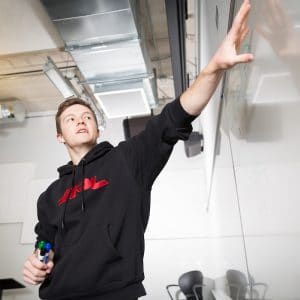Student spotlight
The mathematics of gene mutation
 NAU junior Tanner Rosenberg is working to mathematically describe gene mutation. His pure math research project will have real-world biology applications. “We have gene sequences in our DNA and the most common way they can be mutated is called a reversal where a chunk gets pulled out, flipped over, and put back in so all the genes are upside down and backwards,” he explained. To set up his research, he numbered each gene and marked them as right side up or upside down.
NAU junior Tanner Rosenberg is working to mathematically describe gene mutation. His pure math research project will have real-world biology applications. “We have gene sequences in our DNA and the most common way they can be mutated is called a reversal where a chunk gets pulled out, flipped over, and put back in so all the genes are upside down and backwards,” he explained. To set up his research, he numbered each gene and marked them as right side up or upside down.
“Using that as our mathematical model we can mutate them with these reversals. We’re looking at how messed the gene sequence can get so we can see the greatest number of reversals it takes to mutate it into something else.” From a biological perspective, that information can show the distance between two gene sequences and evolutionary distance.
He, an undergrad, presented his research at the largest conference of mathematicians in the world held in San Diego. Inspired by the work his professors were doing, he got involved in research as a sophomore and added a math major as a result. Between his research and preparation from professors, Tanner said he has confidence that he’ll be ready to enter the job market and be successful. “Research especially forces you to find your own answers, overcome obstacles and try something else,” he said. “It’s really exciting; I’m very proud.”
